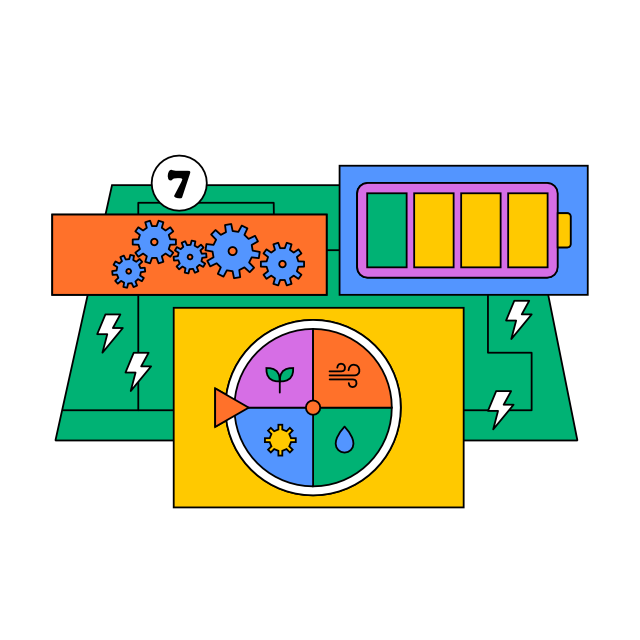SDG 7Affordable and clean energy
How far away is a world without emissions? Is humanity able to use energy in a way that does not destroy us?
Overview
Human civilisation has reached a point where it is clear that if we want to stop destroying the planet, electricity must become the dominant energy source. The transition from an energy system based on burning fossil fuels to emission-free resources as well as the need for a Europe to be energetically independent requires the use of new technologies, particularly an intense use of renewable sources, increased efficiency in storage and a flexible approach. An example: two-thirds of energy today ends up as waste energy. It leaks out during the process of energy production, in transport, industry and during the construction of buildings. By improving energy efficiency, we can ensure a 40% decrease in greenhouse gas emissions over the next 20 years.
We need to realize a key fact. Energy cannot be produced. It can only be converted and then used. The question is how humbly, decently, and smartly we can do it.
Solution and Key Innovations
The energy industry’s holy grail is nuclear fusion which, however, is far from being applicable. It is not until recently that the first fusion experiment produced more energy than the original input. Generally speaking, nuclear fusion is the same reaction that takes place on the Sun. In short, we need to get the hydrogen atoms very close to each other which results in the production of helium and a release of energy. So far, it has been done on a small scale and for a short time only – a miniature Sun of sorts has been created.
One path to general change is to systematically increase the efficiency of solar panels. Laboratory measurements at the independent German Fraunhofer Institute have recently confirmed that perovskite-based photovoltaic cells by the Polish company Saule Technologies achieve solar-to-electricity conversion efficiency of 25.5%, which is a world record. In general, the efficiency of silicon-based solar panels (i.e., conventional solar panels) has been increasing since their 1954 launch – from the original 6% to about 21% today (this value was reached in 2021 as part of the H2020 NextBase European project which includes a team from the Institute of Physics of the Czech Academy of Sciences).
The core of renewable energy source efficiency – where the precise time and amount of production cannot be strictly controlled – is finding an efficient way of storing it. Short-term and low-volume storage is provided by accumulators which are currently undergoing dynamic technological progress. One of the recent solutions has been developed by the UNIGE project laboratories based at the University of Genova and led by a Czech – Radovan Černý. The method uses the replacement of lithium with the much cheaper and more available sodium.
However, large-scale and longer-term electricity storage is still a major issue. The most advanced method is currently electricity storage via hydrogen, methane and ammonia. Recently, Hy2gen has launched the HYNOVERA project in the south of France, aiming to develop a global system for the production of green hydrogen and other biofuels such as green ammonia or e-methanol.
The point is that electricity generated from either solar panels or wind (the sun shines and the wind blows, independent of our needs) produces gas which is then “stored”. Once it is needed, it gets converted back to electricity.
„Energy efficiency is so important in the world’s journey to net zero that it’s nicknamed ‘the first fuel’ by the International Energy Agency (IEA),“ said Fatih Birol, the IEA’s Executive Director.
One way to do this has been offered by a field seemingly unrelated to electricity – tribology, the science of friction, lubrication and wear. Researchers have recently come up with a revolutionary solution, promising to reduce the coefficient of friction. Using tungsten and sulphur nanoparticles, we can not only reduce friction, but also wear on components and tools. Its impact could be huge, as it is not for use just in engineering or the automotive industry. Friction is literally everywhere. Imagine how easy it would be if nothing would scrub or bind. Energy losses worldwide caused by friction and wear could be reduced by up to 40% over a 15-year period.
Key Questions
- Savings versus losses – can we make our consumption more efficient?
- Are our electricity networks secure enough – are we too dependent on electricity?
- Can nuclear fusion work?
- Will humanity understand that we need to conserve our resources?
Key Words
Electricity, alternative, renewable, solar, self-sufficiency, climate change, battery, saving, efficiency, consumption, distribution
